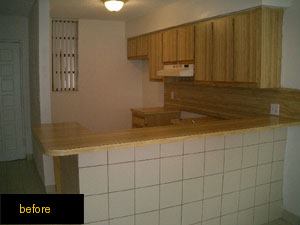Built to Last Kitchens in affordable communities typically get five times the use of those at other properties, says Mark Silverwood, president of Leesburg, Va.-based Silverwood Associates Inc. “[These residents] are not the ones going out to dinner,” he says. “These are working families with kids, using the kitchen a lot more often.”
That’s why durability is a primary consideration when Silverwood chooses materials for extensive rehabs at 50-year-old properties in Arlington and Alexandria, Va. Typical selections for these communities include white or almond GE appliances, oak cabinets, Formica countertops, and vinyl flooring. The company also enlarges windows and replaces dim 60-watt bulbs with 4-foot-by-4-foot fluorescent fixtures. Rehabs cost up to $7,000 per kitchen.
Creating space also is a top priority, says Silverwood. Built in the late ’40s and early ’50s, most of the properties’ kitchens have a galley design with all cabinets and appliances on one wall. Since the kitchens typically are wedged between living rooms and bathrooms, the company moves the living room wall out 12 to 18 inches and puts cabinets on both sides of the kitchen.
Case Study: Going Retro DARO Realty’s portfolio dates back to the ’20s and ’30s. Kitchens, last remodeled in the ’70s, offer dark oak cabinets with faux butcher-block countertops and a dull brown tile floor. Although the company had added white appliances in the ’90s, “it just wasn’t pretty,” says K. David Meit, executive vice president. So for the past two years, the Washington-based owner and manager has been aggressively rehabbing both kitchens and baths – two of the biggest selling points in apartments.
“We put a lot of thought into how we wanted our kitchens to look, and we decided to be true to ourselves and not try to be something that we are not,” Meit explains. DARO didn’t want to imitate a modern kitchen, which typically features maple cabinetry and almond appliances. “Black and white is what our kitchens looked like when they were first built, and we find that the people who want to live in our buildings are looking for that,” Meit says. “They are willing to not have wall-to-wall carpeting and washers and dryers in their apartments because they want to have that traditional feel.”
To play up the ’20s look, DARO added black and white checkerboard vinyl floors and traditional white cabinetry, with faux granite countertops for a slight contemporary feel. The company also installed white GE appliances. DARO has gotten the rehab process down to a science. Upon turnover, units are renovated by a turnkey contractor. Updating a kitchen costs around $5,000 and takes about two weeks.
While a new kitchen certainly adds value, the company can’t specify a rent increase, since properties are rent-controlled.
For its Washington properties at a lower price point, DARO decided not to make such a large investment. Many units have oak cabinets that are only five years old, so in-house maintenance crews will replace butcher-block countertops with Formica almond ones for around $200 and add white appliances for $600 to $800. “The cosmetic aspects of the apartments to the prospect aren’t as important,” Meit says. “As long as it’s updated and it looks clean, they are happy.”
